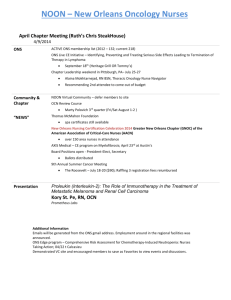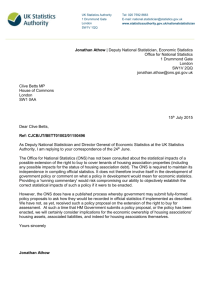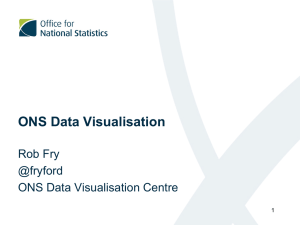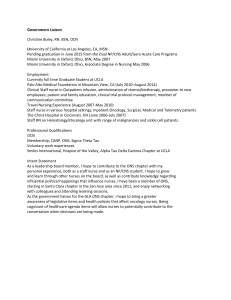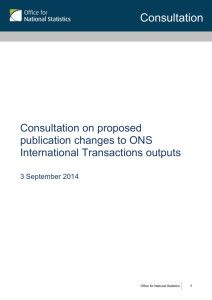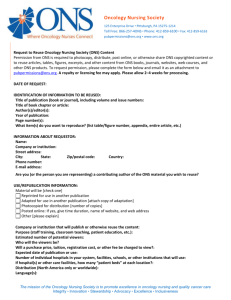Measuring the Digital Economy - Office for National Statistics
advertisement
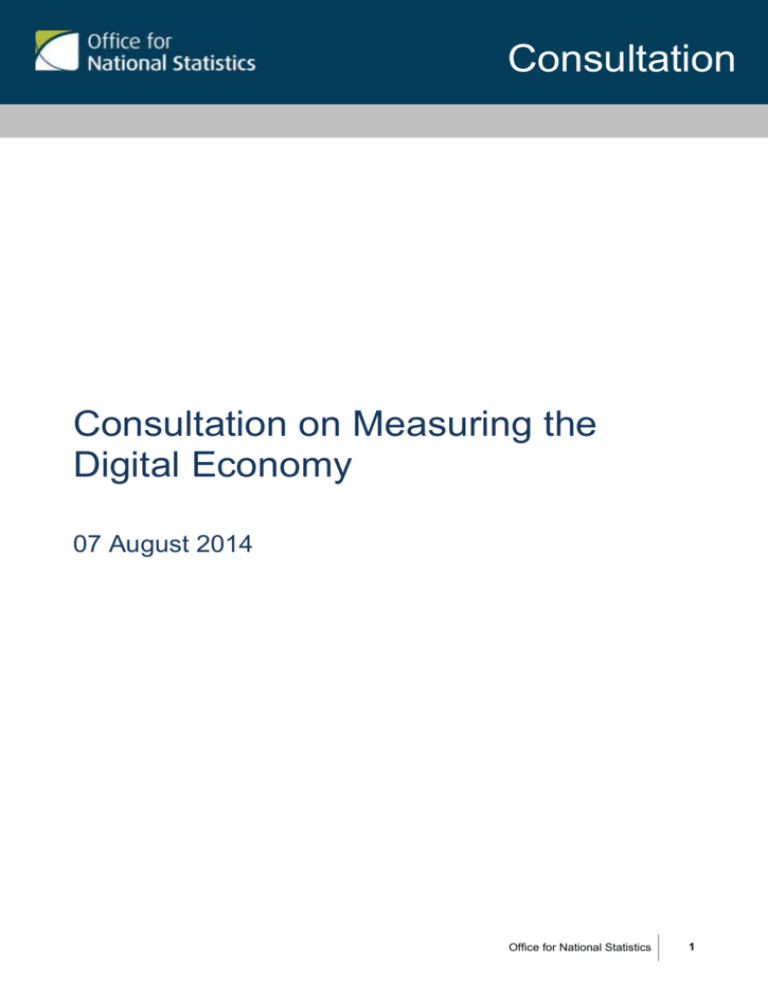
Consultation Consultation on Measuring the Digital Economy 07 August 2014 Office for National Statistics 1 Document name here Summary The Office for National Statistics (ONS) publishes a range of statistics on the digital economy. To ensure these statistics continue to meet user needs, ONS would like to hear from users on how the current data are used, preferences for future publication of the statistics, and what other statistics on the digital economy would be helpful. Introduction On 7 August 2014, ONS launched a public consultation on the future publication of statistics that measure the digital economy. ONS would like to hear: 1. Which ONS digital economy statistics are helpful to users? 2. How are ONS digital economy statistics used? 3. What would users prefer in terms of the timing and content of future publications of those statistics previously contained in the ‘Internet Access Quarterly Update’? 4. Would an indicator set similar to that proposed in the ‘Monitoring e-commerce’ article be of value to users? 5. Is there value for users in expanding the e-commerce survey to broaden the industry and/or business size coverage? 6. What other statistics on the digital economy would be helpful to users? 7. Whether users would like to be members of a new ‘Measuring the digital economy’ user group that is being considered? Background The Office for National Statistics publishes a range of statistics on the digital economy. These include the following: 1. E-Commerce and ICT Activity: provides detailed information about e-commerce and the adoption and use of Information and Communication Technologies by UK businesses; provides answers to questions such as ‘What proportion of businesses have a website?’, ‘What proportion of business turnover was generated from e-commerce?’, and ‘What proportion of businesses have broadband?’; data are collected with reference to the previous year on the E-commerce Survey and are published annually in December; estimates cover businesses with 10 or more employees in the majority of industry sectors.1 2. Internet Access - Households and Individuals: 1 The statistics do not cover businesses with the following industry classifications (Standard Industrial Classification 2007): Section A - Agriculture, Forestry and Fishing; Section B - Mining and Quarrying; Section K - Finance and Insurance Activities; Division 75 - Veterinary Activities; Section O - Public Administration and Defence, Social Security; Section P - Education; Section Q - Health and Social Work; Section R - Arts, Entertainment and Recreation; Section S - Other Service Activities except SIC 95.1 - Repair of computers. Office for National Statistics - Measuring the digital economy consultation 2 Document name here provides detailed information about individuals’ use of the Internet and how households access the Internet; provides answers to questions such as ‘What proportion of adults use social media?’, ‘What proportion of adults shop online?’, and ‘What proportion of households have a broadband connection?’; data are collected in the first quarter of the year on the Opinions and Lifestyle Survey; estimates cover adults in Great Britain and are published annually in August; the survey collects a large range of information on Internet use but the modest sample size means that detailed breakdowns by socio-economic and demographic characteristics are not possible. Recent developments Discontinuation of the Internet Access Quarterly Until recently, the ONS also published an Internet Access Quarterly Update. This publication has been discontinued as a result of the ONS Consultation on Statistical Products, 2013 and an annual update will be published instead. The final edition of the ‘Internet Access Quarterly Update’ was published on 14 May 2014, for Q1 2014. The Internet Access Update (Quarterly and Annual): provides information about the number of individuals who have used the Internet by various socio-economic and demographic characteristics, such as age, sex, disability, geographical location (including sub-region) and weekly earnings; provides answers to questions such as ‘How many people have never used the Internet?’, ‘Are men more likely to have used the Internet than women?’, and ‘Are adults in London more likely to have used the Internet than those in other regions of England?’; data are collected on the Labour Force Survey; estimates cover adults in the UK; the large sample size means that detailed breakdowns by socio-economic and demographic characteristics are possible, however, there is only one question related to Internet use. Review of statistics measuring the digital economy and proposals for an indicator set In 2014 ONS began a project to consider how it could contribute to the monitoring of e-commerce nationally. This was a consequence of a 2013 European Union e-commerce taskforce, chaired by Lord Young of Graffham. The initial phase considered, but rejected, the idea of creating a national ‘e-commerce index’. Instead a report ‘Monitoring e-commerce’ article published on 7 August 2014 proposed the use of an indicator set, combining a dashboard approach alongside an interactive graphic, to allow users to take an over-arching and flexible view of the topic. The report also highlighted some future developments which could be carried out, depending on the views of stakeholders and subject to resource constraints. The two key recommendations were: Any indicator list should be flexible and reflect changes to the e-commerce landscape. ONS, with input from stakeholders, to keep the proposed list of indicators under review. Office for National Statistics - Measuring the digital economy consultation 3 Document name here ONS, with users, to look into expanding the e-commerce survey to broaden the industry and/or business size coverage, and whether the sample size of the survey could be increased. Future developments To ensure digital economy statistics continue to meet user needs, ONS are now taking the opportunity to consult with users to find out preferences for the future publication of Internet access statistics. In addition views on the proposed indicator set and future measurement of e-commerce are also sought. A full list of questions can be found in our online questionnaire, or in Annex A. Discontinuation of the Internet Access Quarterly There are two main options for the annual publication of the Internet Access Update (previously the Internet Access Quarterly Update): 1) statistics could be published in a separate publication in May each year, or 2) statistics could be combined into a joint publication with the ‘Internet Access – Households and Individuals’ release in August each year. The benefit of Option 1 is that information on who has used the Internet is available sooner, with the detail of how individuals and households are using the Internet available slightly later. The drawback with this option is that users have to use two separate publications to find all of the published ONS statistics on Internet access for individuals. However, while Option 2 means there is one release of ONS statistics on Internet access for individuals, users would have to wait longer for some of this information. Regardless of which option is chosen, when the information from the ‘Internet Access Quarterly Update’ is published it could: a) include statistics for one quarter for each year, or b) include statistics for every quarter in the year since the last publication. ONS would like to understand users’ preferences for Options 1) and 2) and Options a) and b). User needs will then be assessed against costs and respondent burden. Measuring the digital economy and proposals for an indicator set ONS would like to understand whether the proposed indicator set would be of value to users, and what the value would be to users of expanding the e-commerce survey to broaden the coverage. ‘Measuring the digital economy’ user group The digital economy is constantly evolving and it is important to make sure the ONS statistics collected and published in this area are regularly reviewed to ensure they remain relevant for users. As such, ONS are considering setting up a new ‘Measuring the digital economy’ user group to help inform future direction for the collection and publication of statistics in this area. Office for National Statistics - Measuring the digital economy consultation 4 Document name here ONS would like to know if you, or someone in your organisation, would like to be a member of the new user group. ONS will select members from those interested to make sure the group reflects a range of users. Consultation Interested parties are invited to complete the online questionnaire, or the questionnaire in Annex A. Responses will be used to inform the future collection and publication of statistics to measure the digital economy. Confidentiality and data protection The basics… As someone who is interested in ONS statistics, we’d welcome your views. We may ask you to tell us who you are so that, where appropriate, we can follow up on the feedback you give. Your response might be made available if required under a Freedom of Information request, but we would only do so in a way that was within the law. All findings will be anonymised when we report the outcomes of this consultation. The details… The information you send us may be passed to colleagues within ONS and other parts of Government. Information provided in response to this consultation, including personal information, may also be published in accordance with access to information legislation including the Freedom of Information Act 2000 (FOIA). If you want the information that you provide to be treated as confidential, please be aware that, under the FOIA, there is a statutory Code of Practice with which public authorities must comply. This Code, amongst other things, deals with confidentiality. Because of this it would help if you gave us a short explanation of why you think confidentiality is necessary. If we receive a request for disclosure of the information we will take full account of your explanation, but we cannot give an assurance that confidentiality can be maintained in all circumstances. Please ensure that you email ons.communications@ons.gsi.gov.uk if you wish your response and your name to be kept confidential. Confidential responses will be included in any summary of numbers of comments received and views expressed. Consultation timetable This consultation will run from 7 August to 30 October 2014. How to respond to the consultation Responses to the consultation can be completed using our online questionnaire. Alternatively, responses can be submitted by sending the questionnaire in Annex A to: esociety@ons.gsi.gov.uk Paper copies of the template can be sent to: Office for National Statistics - Measuring the digital economy consultation 5 Document name here Heather Bovill, Office for National Statistics, Room 1.362, Government Buildings, Cardiff Road, Newport, NP10 8XG. The Government’s Code of Practice on Consultations This consultation follows the Government’s Code of Practice on Consultation. The full Code of Practice is available at: After the consultation We will publish a response to the consultation before the end of 2014. The response will include a summary of the comments made and the next steps for the publication of statistics to measure the digital economy. Getting in Touch If you have any queries or comments about the consultation process, please email Simeon Bowen at ons.communications@ons.gsi.gov.uk or call 0845 601 3034. You can also write to us at the following address: Customer Contact Centre, Office for National Statistics, Government Buildings, Cardiff Road, Newport, South Wales, NP10 8XG. For further information on ONS consultations, please visit http://www.ons.gov.uk/ons/aboutons/get-involved/consultations/index.html Follow us: Facebook Twitter LinkedIn YouTube Google+ Storify Crown Copyright © Crown copyright 2014 You may re-use this document/publication (not including logos) free of charge in any format or medium, under the terms of the Open Government Licence v2.0. Where we have identified any third party copyright information you will need to obtain permission from the copyright holders concerned. To view this licence visit: www.nationalarchives.gov.uk/doc/open-government-licence/version/2 email psi@nationalarchives.gsi.gov.uk Office for National Statistics - Measuring the digital economy consultation 6 Document name here Annex A: Consultation questions (a response template is available on ONS website) 1a) Which ONS digital economy statistics do you use? 1. E-Commerce and ICT Activity Yes/No Internet Access Quarterly Update Yes/No Internet Access - Households and Individuals Yes/No Please provide details of specific statistics used, for example, e-commerce statistics by business size or Internet usage figures by age. 1b) How useful do you find ONS digital economy statistics on a scale of 1 to 5, where 1 is not at all useful and 5 is very useful? 2. E-Commerce and ICT Activity 1 2 3 4 5 N/A Internet Access Quarterly Update 1 2 3 4 5 N/A Internet Access - Households and Individuals 1 2 3 4 5 N/A Office for National Statistics - Measuring the digital economy consultation 7 Document name here 2) What do you use ONS digital economy statistics for? 3a) What are your preferences for the timing of future annual ‘Internet Access Update’ publications? No preference/Don’t use Published in a separate publication in May each year Combined into a joint publication with the ‘Internet Access – Households and Individuals’ in August each year 3b) What are your preferences for the content of future annual ‘Internet Access Update’ publications? No preference/ Don’t use Include statistics for one quarter for each year Include statistics for every quarter in the year since the last publication Office for National Statistics - Measuring the digital economy consultation 8 Document name here 4) Would an indicator set similar to that proposed in the ‘Monitoring e-commerce’ article be useful? Yes No Don’t know If yes, how would you use this information and what decisions would it inform? 5) Would the expansion of the e-commerce survey to broaden the coverage, for example, to include businesses with less than 10 employees and/ or a wider range of industry sectors, be beneficial? Yes No Don’t know If yes, please explain which expansion you would be interested in, the benefits and the decisions the new information would inform. Office for National Statistics - Measuring the digital economy consultation 9 Document name here 6) What other statistics on the digital economy would be helpful for your work? Please explain why these statistics are important and what decisions they would help to inform if they became available? 7) Would you, or someone in your organisation, be interested in becoming a member of a new ‘Measuring the digital economy’ user group? Yes No Don’t know If yes, please provide relevant contact details: Office for National Statistics - Measuring the digital economy consultation 10 Document name here 8) Please provide any other comments you wish to make Name Organisation (if applicable) Telephone number Brief background on your (organisation) area of interest Email address Is this a personal response or on behalf of an organisation? Please enter in the box to indicate your response: Personal response On behalf of an organisation (please state which organisation above) Office for National Statistics - Measuring the digital economy consultation 11
